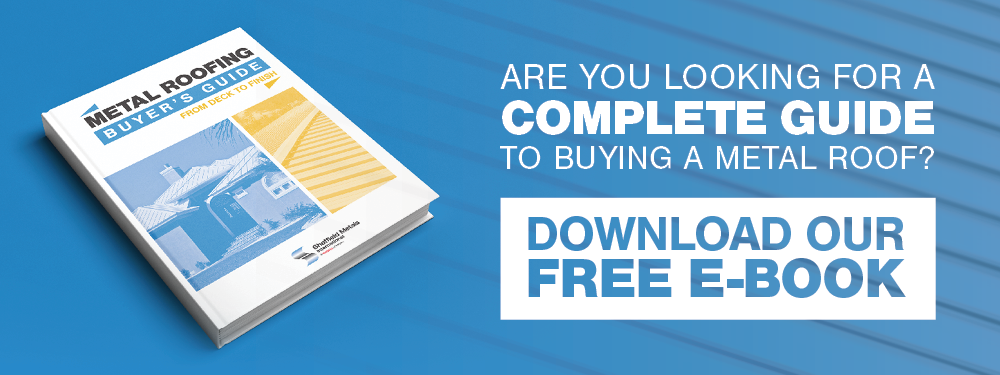Copper metal roofing has been growing in popularity, especially as the raw metal color trend continues to dominate in exterior building products.
However, did you know that there are more options than using actual copper for your roofing system? You can also opt to purchase a steel (Galvalume) or aluminum substrate that has a copper-colored paint system coating.
But how do you know which material to choose for your specific project?
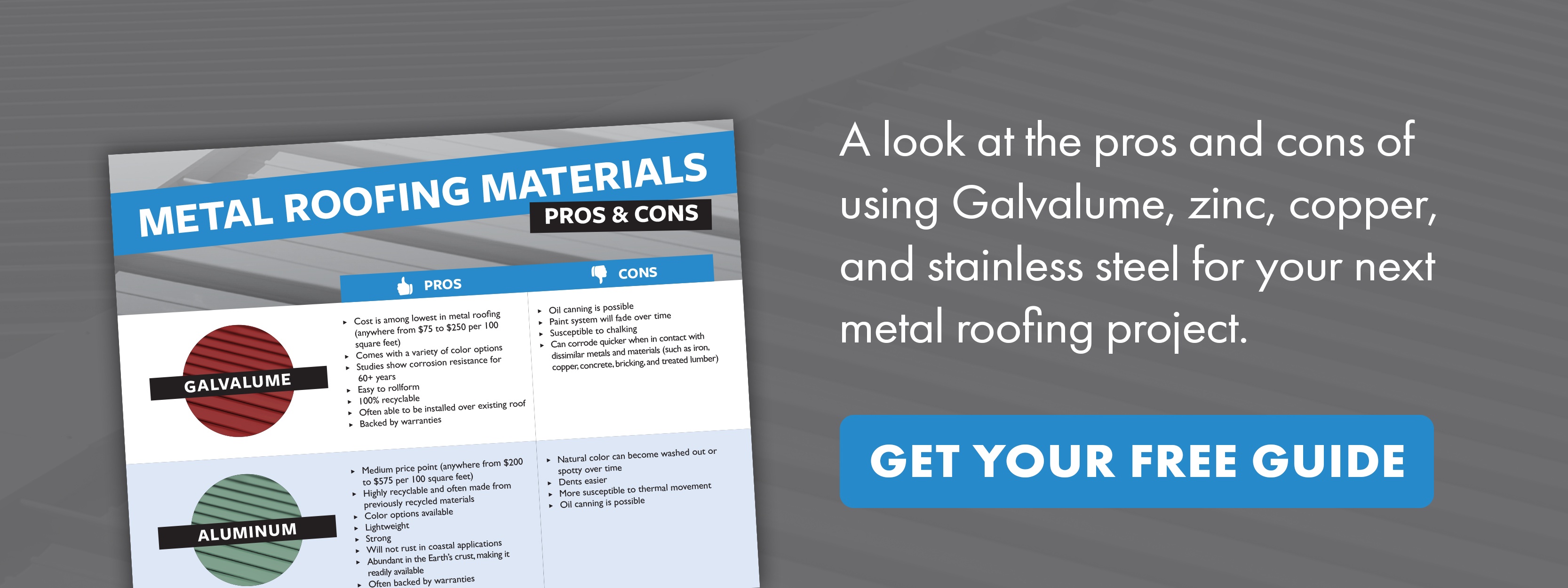
Sheffield Metals is one of the leading distributors of coated and bare metal products in the standing seam metal roofing industry. We sell Galvalume, aluminum, and copper products and are often asked why these materials may or may not be a good product choice. Plus, we know how important it is to be an educated consumer, especially when purchasing something as significant as a new roofing structure.
So, what are the differences, uses, advantages, and disadvantages of copper roofing vs. a copper-color painted metal? Let’s discuss.
Real Copper Metal Roofing: Advantages & Disadvantages
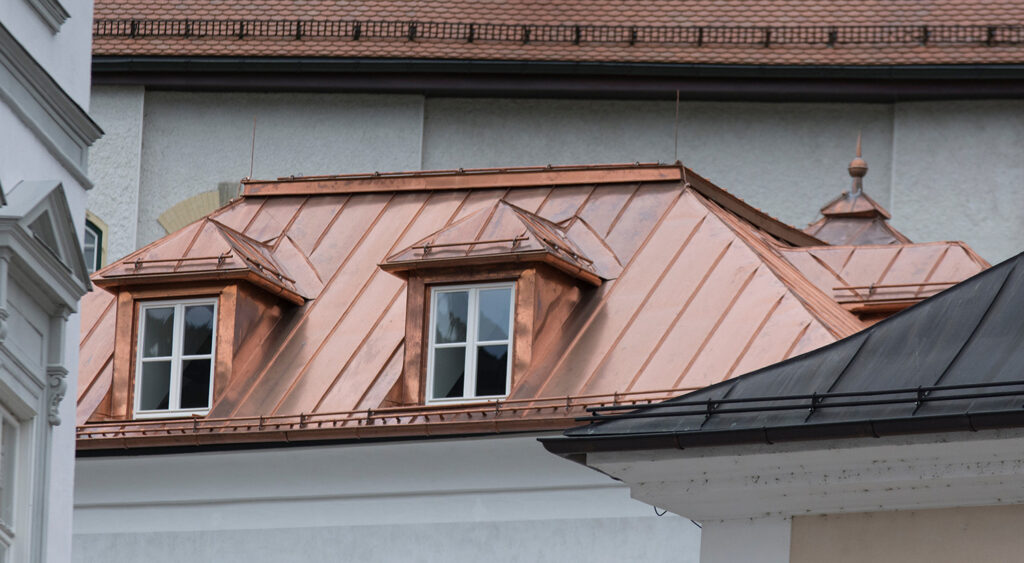
Copper is a reddish-orange metal that is malleable, ductile, and has high thermal and electrical conductivity.
The use of copper roofing has been around for hundreds, if not thousands, of years. Historical data shows that the Romans used copper covering on the roof of the Pantheon in 27 B.C.
Today, copper is an eye-catching roofing material for architectural projects, commercial buildings, and residential homes. Many property owners also utilize copper as an accent portion of their roof or have copper cupolas, chimney caps, awnings, and more.
Pros of Choosing Real Copper Roofing
Offers the most realistic aesthetic – Copper is often referred to as a premium roofing material, as it enriches the outside of a building and adds a metallic reddish-orange/brown focal point to a structure. Compared to copper-colored PVDF-coated Galvalume or aluminum, natural copper gives you that real shine and luster of the metal’s raw form. Ultimately, if you’re looking for a roof system that gives you the color and patina (discussed next) of a copper roofing system, you should choose the actual metal.
Develops patina – One of the significant advantages of choosing an actual copper roof is that it will produce a patina as it ages. Patina is a protective covering that develops on the surface of metals and metal alloys through exposure and aging. Most patinas on metal roofing happen because of oxidation and sun exposure.
As copper experiences natural or human-induced corrosive attack, its color changes from the iridescent, golden red normally associated with pure copper to a deep brown and, finally, to hues of blue and green.
Many home and building owners specifically buy copper because of how it ages and adds to the curb appeal and visual interest of a structure over time.
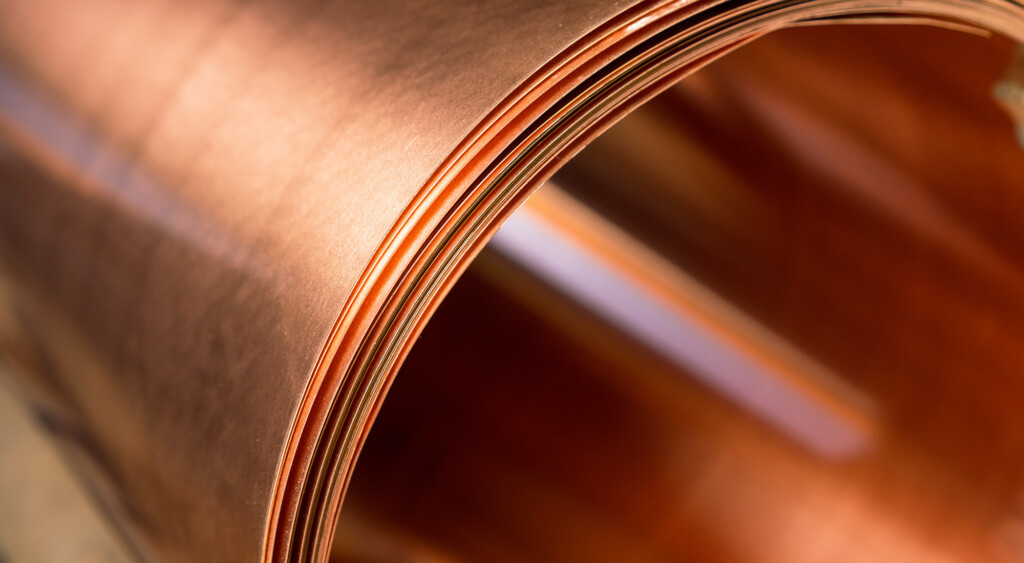
Lightweight – Copper is lightweight compared to metal materials like steel (or Galvalume) and other roofing materials such as shingles, concrete, or tiles. This makes it easier for installers and contractors to work with, but it also puts less stress on the structure over time. All metal roofing is very lightweight and should not be a cause for concern.
Durability for decades – Another benefit of a real copper roof is its durability, especially as it ages. Patina development creates a barrier that protects the metal and reduces the effects of corrosion. That’s why, if copper roofing is installed correctly, it can last 100+ years in some instances. Copper also works well in locations with heavy snow, frequent rainfall, and strong winds.
Solderable – Copper can be soldered, unlike other roofing materials. This means roof/wall flashings and gutter joints can be weathertight with a soldered connection.
Some warranty options – Coated copper material can have limited substrate warranty options. However, most bare copper products do not have a substrate warranty. Before purchasing a roof, verifying the available warranty options with your contractor or manufacturer is best.
Cons of Choosing Real Copper Roofing
Higher cost – The price is the most significant drawback of choosing a real copper roof over a copper-color paint system. Copper is a more costly metal roofing material, as this element is not as abundant on Earth. Plus, copper prices fluctuate almost weekly, so it’s difficult to predict the exact pricing. However, you can expect copper roofing to cost anywhere from $15 to $20 per square foot.
Limited panel profile (and engineering) options – There are limited panel profile options available for copper standing seam metal roof systems, and therefore limited engineering options. Almost all high-performing copper profiles are mechanically seamed, as the metal is too soft for a snap-lock or fastener flange panel system.
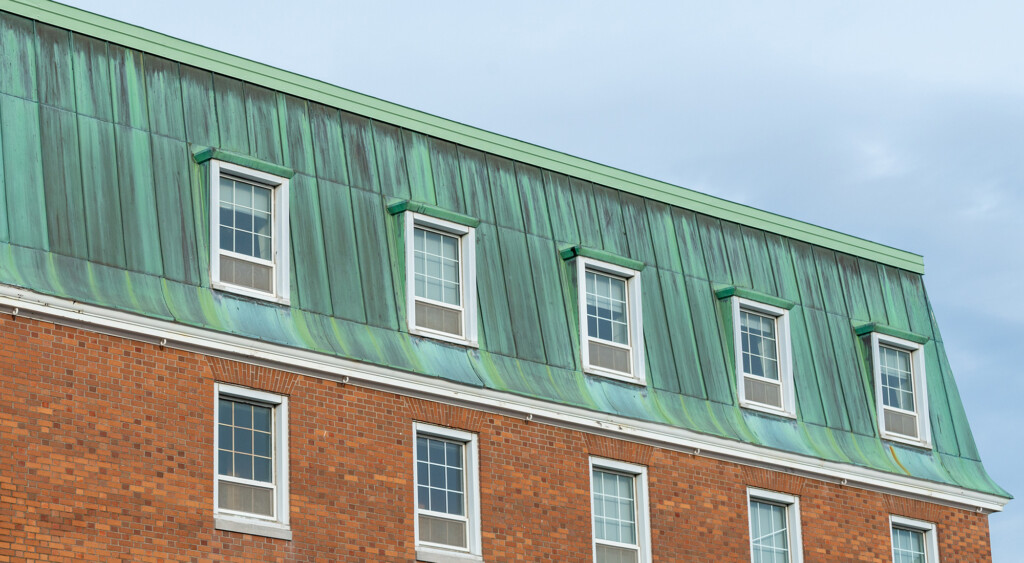
Unpredictable patina – Some people are drawn to the look of the patina that will happen on a copper roof, but some might not want this greenish-blue covering on their home or structure. There is currently no exact science to predict the color or time frame that patina will occur with copper. Several variables, including temperature, exposure time, humidity levels, environmental chemicals, and the metal’s general surface condition ultimately determine the patina’s evolution and color. It’s important to understand that, depending on your environment, some patinas will turn a rich blue/green, and others will maintain a dark brown hue. Also, keep in mind that copper usually loses its luster pretty quickly and you get a long period of a dull brown color.
Expansion and contraction concerns – In climates with striking temperature differences, copper roofing expands and contracts during heating and cooling cycles (more than steel but less than aluminum metal systems). This is why it’s critical to hire a contractor who has experience installing actual copper roofing and understands how your environment may affect the thermal movement of this material.
Dissimilar metals issues & run-off staining – Copper roofing and copper products generally do not interact well with most other metal products used in roofing. Knowing what products are used in the entire roof assembly is essential to prevent dissimilar metal corrosion; this is especially true with clips and fasteners. This includes water run-off from the copper onto dissimilar metals as well. Another concern with copper roofing is that the rain run-off is known to stain siding, brick, concrete, other metals, wood, etc. Home or business owners need to be aware of this factor and ensure the contractors install the roof so the water can safely run off it without contacting other materials that stain easily.
Copper Color Painted/Coated Metal: Advantages & Disadvantages
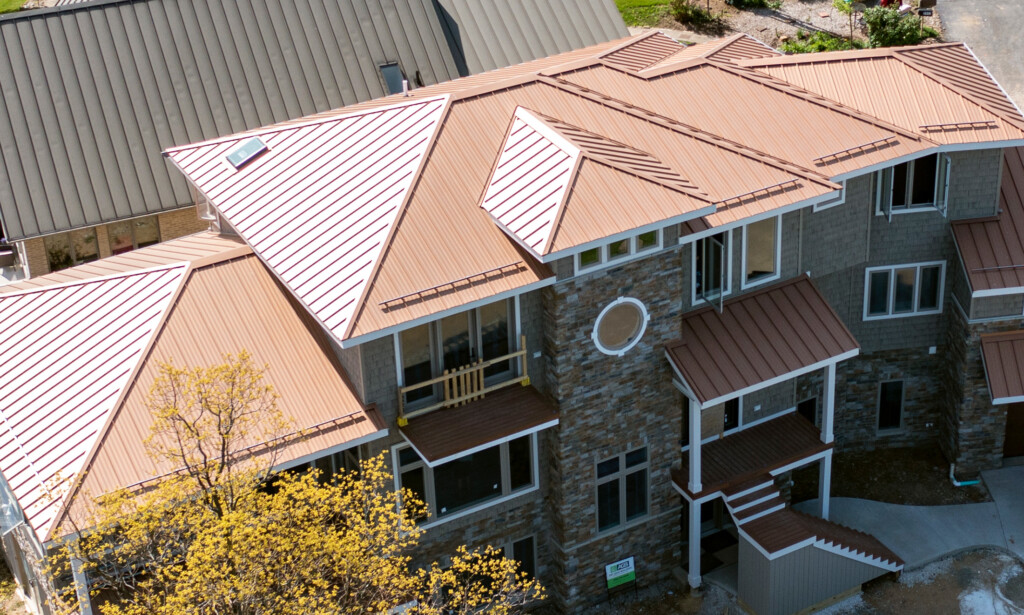
Copper-color paint systems applied to a metal substrate — typically Galvalume or aluminum — are becoming more common as the paint technology advances.
Most sheet and coil products for the architectural metal roofing industry are coated in a PVDF (polyvinylidene fluoride) paint system, a high-performance coating that withstands extreme temperatures, sun exposure, oxygen, humidity, and pollution particles in the atmosphere. Copper-colored pigments are added to the paint system formula to mimic the color of actual copper.
Like natural copper, PVDF-coated metal is heavily used in architectural projects, commercial buildings, and even some residential homes.
Pros of Choosing Copper-Colored Roofing
More economical price vs. real copper – The most significant advantage to choosing a copper-colored paint system is that it costs significantly less than an actual copper roof — even with the addition of a premium Copper Metallic paint system.
You can expect the following price points for a coated metal roofing system:
- Galvalume: Approximately $5.00 to $15.00 per square foot
- Aluminum: Approximately $7 to $18.00 per square foot
Remember that in 2023, aluminum and steel prices are continually fluctuating, so the price can vary dramatically.
Metal substrate material options – One of the benefits of choosing a copper PVDF paint coating is that it can be applied to several different substrates, including Galvalume (steel) and aluminum. This is beneficial because different environments require different substrates to resist corrosion better, i.e., aluminum is always recommended in coastal environments. Or, if you live in a non-coastal region, you can utilize a traditional and more readily available Galvalume system.
More warranty options – One of the number one selling points of a PVDF-coated metal roof or wall is that it comes with various warranty options, including paint or finish warranties, substrate warranties, and the optional weathertight warranty (non-residential applications only). While real copper may have some warranty options, they are likely minimal. Most home and property owners want to protect their investment and know that the roof or wall system will last through a warrantied promise, which is possible with many copper-colored paint coatings over Galvalume and aluminum. (Note: Substrate or paint warranties are NOT available for Galvalume products within 1,500 feet of a coast.)
Easier to handle & install – Another benefit of choosing a painted Galvalume or aluminum system is that it’s not as temperamental as copper. Installers don’t have to worry as much about leaving fingerprints, deep scratches, etc., on panels because these two metals are more rigid and tolerable. It also doesn’t have many strict ventilation or air gap requirements like some other metals. Galvalume is a standard metal roofing product with few special requirements, which allows the installation details to be pretty standard across the board. Even though it’s a tough material, installers still find Galvalume easy to handle, rollform, cut, etc.
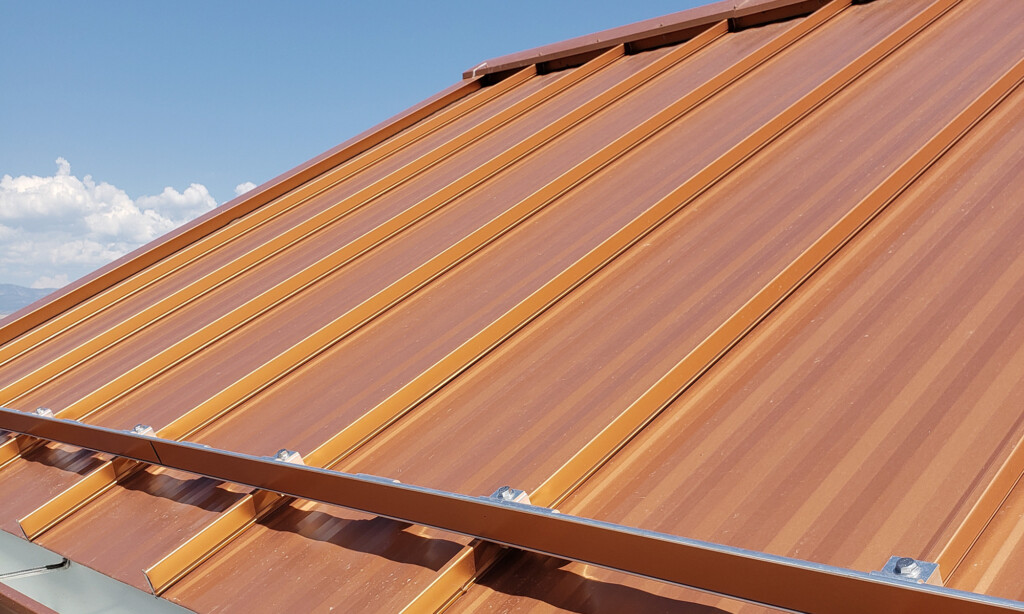
More qualified installers – To go along with the easier installation properties is the fact that more qualified and skilled contractors can install Galvalume and/or aluminum. Working with real copper requires a specific skill set and experience, which can make it tough to find a contractor in specific areas of the country.
Never going to patina – Some home and commercial property owners like the look of copper and want it to stay that reddish-brown color for decades. Unfortunately, you cannot control how actual copper patinas over time. So, if you like the look of copper but don’t want any patina to develop, choosing a Galvalume or aluminum system with a PVDF copper-colored coating is the way to go.
Cons of Choosing Copper-Colored Roofing
Not the real metal – The most obvious con of choosing a copper PVDF color coating is that it only mimics a similar look to a copper roof. Paint technology has come a long way in the last 20 years, and there are now some color options that get close to real copper, such as Copper Metallic and Copper-Ten™ Raw. However, it’s important to note that these paint systems will never look exactly like copper, as they lack the raw materials’ initial luster and shininess.
Metallic coating drawbacks – One of the lesser-known issues with Metallic finishes is that the reflective pigments in the paint are directional. This means the light reflects in only one specific direction. To help with this issue, there is an arrow on the back of Metallic-coated sheets and coils. This is critical for installers and manufacturers to pay attention to, as the roof or wall must all be installed in the same direction according to the arrows. This ensures that light isn’t reflected in different directions from panel to panel, which can create visual stripes if not correctly aligned.
Additionally, Metallic finishes cannot be measured for color changes (fading) due to the reflective pigments, meaning a paint warranty does not cover color changes.
Doesn’t develop patina – You might be asking why this is both an advantage and a drawback; it all depends on what you want your roof to look like down the line. If you like the look of a patina and want it to develop, you should stick to choosing real copper won’t experience significant color change.
Longevity is excellent, but not as long as copper – Research indicates that Galvalume roofing could last 50+ years in the right environment without any extreme corrosion. Since many asphalt shingle roofs only last 10-15 years, Galvalume and copper roofs are significantly better. However, compared to the 100+ years that copper roofs have been known to last, a Galvalume roof will likely not last beyond 50+ years.
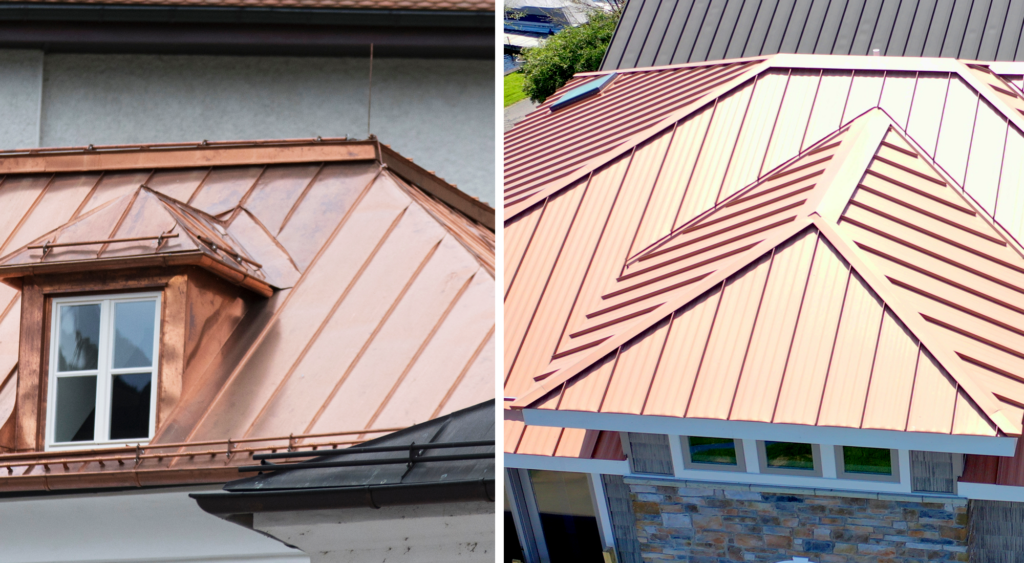
Final Thoughts on Real Copper vs. Copper Color Painted/Coated Metal
So, should you choose a real copper or a copper-colored roof system?
To help guide you in the decision-making process, let’s go through a few scenarios to help you determine if an actual copper roof or a copper-colored paint system over Galvalume or aluminum is the better choice.
- Scenario #1: You want your roof or wall to look like real copper.
- Best material: Actual copper
- Scenario #2: You DO NOT want a patina to develop on your roof.
- Best material: Copper-colored PVDF paint system over Galvalume or aluminum
- Scenario #3: You do want a patina to develop.
- Best material: Actual copper
- Scenario #4: You have a limited budget.
- Best material: Copper-colored PVDF paint system over Galvalume or aluminum
- Scenario #5: You want or need a warrantied and/or engineered product.
- Best material: Copper-colored PVDF paint system over Galvalume or aluminum
- Scenario #6: You want a roof system that will last for decades.
- Best material: Actual copper OR a copper-colored PVDF paint system over Galvalume or aluminum
At Sheffield Metals, we are dedicated to educating buyers with the information they need to make the best and most informed roofing system decision — whether the material you choose is Galvalume, aluminum, copper, or another material.
Our knowledgeable and experienced metal roofing specialists are ready to answer all of your questions; contact us today!
